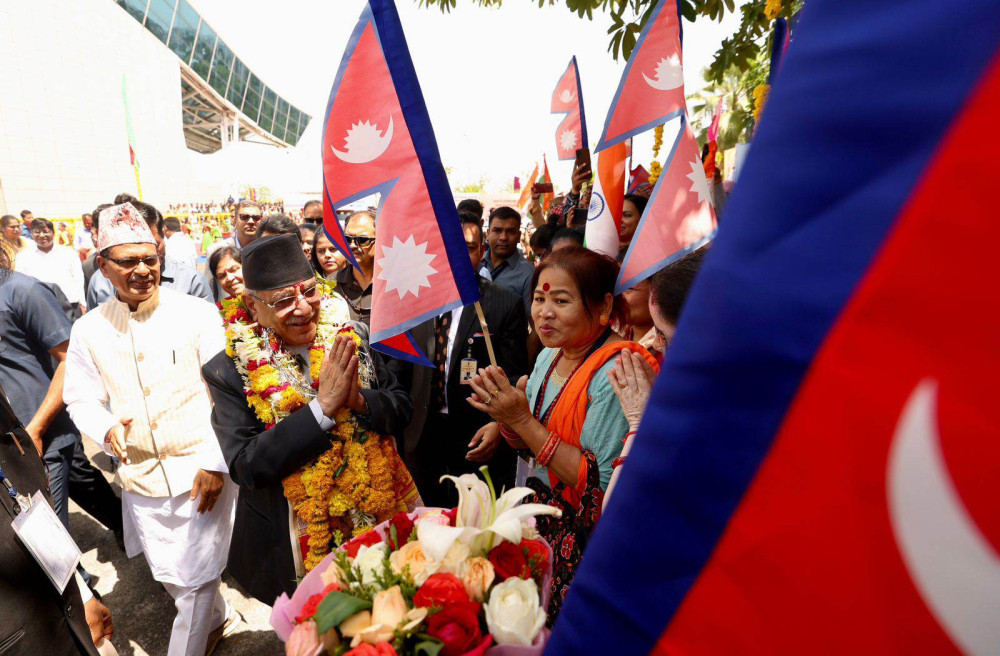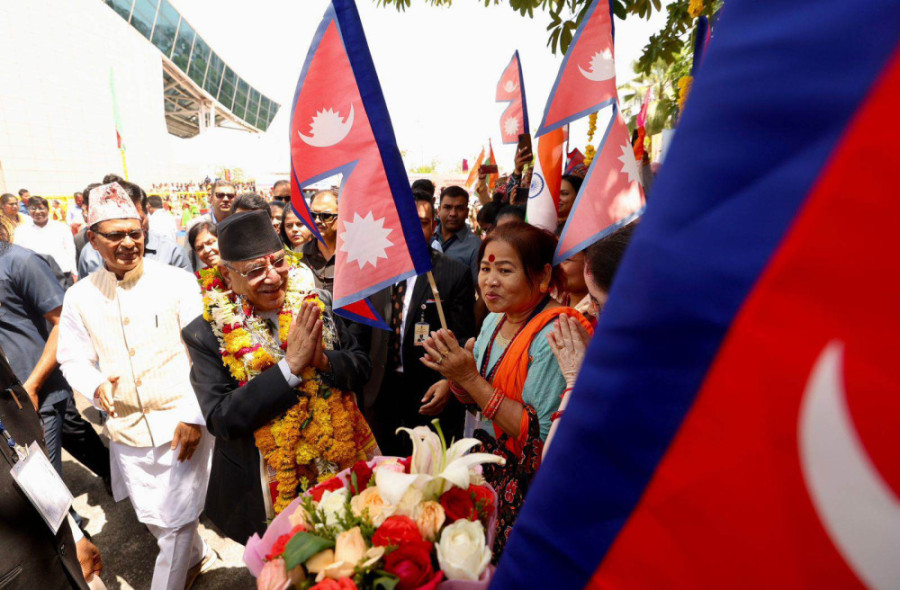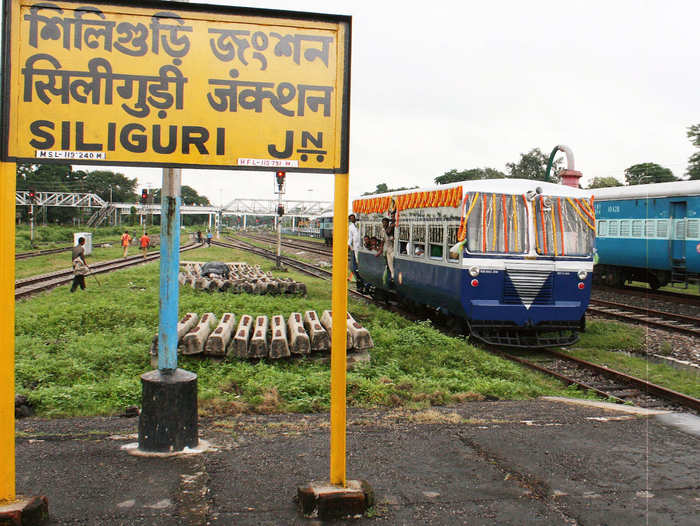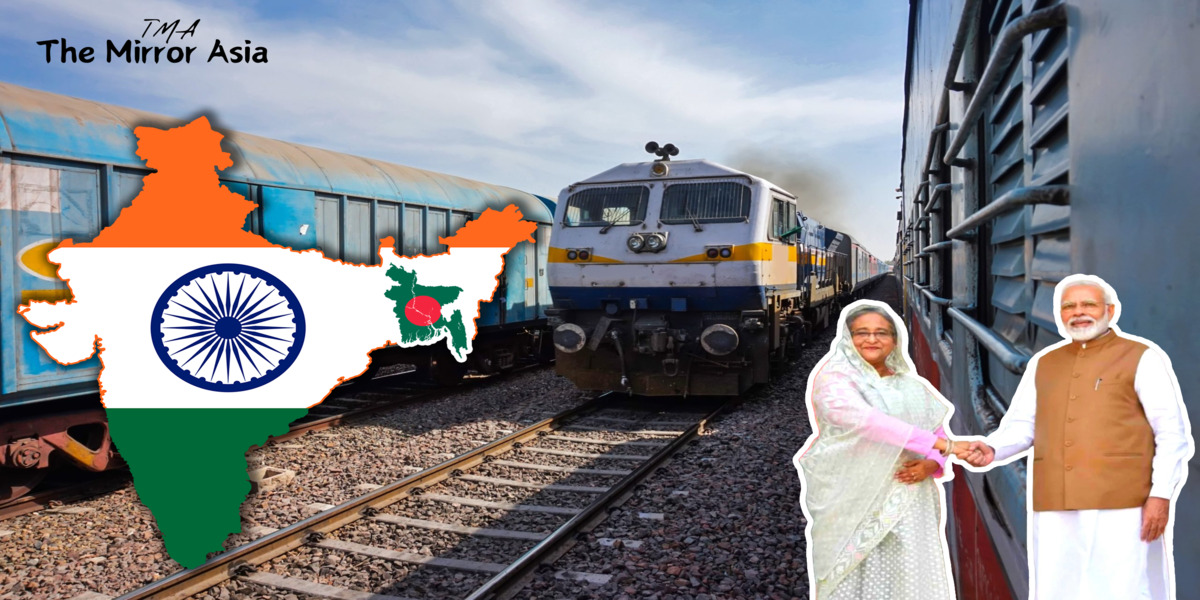Saif
Senior Member
- 13,656
- 7,405
- Origin

- Axis Group

Siliguri Corridor and its geostrategic importance.
Follow along with the video below to see how to install our site as a web app on your home screen.

Note: this_feature_currently_requires_accessing_site_using_safari




















This Indian gentleman talks about annexing some Bangladeshi land to widen chicken neck. His audacity knows no bound.

What if China wrings India’s ‘Chicken’s Neck’ – the Siliguri corridor? Here are some countermeasures
The Siliguri corridor, a narrow passage to India’s eight north-eastern (NE) states, is a perennial threat to our security. Strategically, it is the Achilles heel in the defence of almost 2,000 km of borders in...timesofindia.indiatimes.com
What if China wrings India’s ‘Chicken’s Neck’ – the Siliguri corridor? Here are some countermeasures
October 9, 2019, 7:50 PM IST Mohinder Pal Singh in TOI Edit Page, Edit Page, India, World, TOI
The Siliguri corridor, a narrow passage to India’s eight north-eastern (NE) states, is a perennial threat to our security. Strategically, it is the Achilles heel in the defence of almost 2,000 km of borders in the NE states with China and Myanmar. This piece of land is about 60 km in length but a meagre 22 km in width at its narrowest point. With plain terrain not interspersed with any natural or man made obstacles, this patch makes defence a real challenge.
Undoubtedly, this 2,000 sq km stretch of land will be the prime and early target of the enemy during any confrontation. Naturally, the road corridor passing through this narrow corridor becomes a vital piece of ground which must be defended at all costs.
In 2003, India and China came to an agreement whereby China agreed to Sikkim’s addition to India and gave up all claims to the state and India recognised China’s sovereignty over Tibet. Whilst this significantly reduced the escalation in the India-Bhutan-China tri-junction region, China’s attempts to seize de facto control over the region continued. It culminated in the Doklam standoff between India and China during June-August 2017.
The threat to the Siliguri corridor (also known as Chicken’s Neck) is perennial as China has continued its overt road and airstrip construction activities on its side of the border. This could allow China to rapidly mobilise and deploy troops thereby threatening the Siliguri corridor. Furthermore, the deployment of artillery, missiles or anti-aircraft weaponry could easily jeopardise India’s efforts to resupply the region in time of war, especially considering that there is only a single railway line through the region to NE states.
Widening and strengthening this corridor is imperative. The first option for India is to enter into a treaty with Bangladesh permitting not only transit of military equipment during times of conflict but also civilian traffic and trade activities. This would add a layer of strategic depth in the region and alleviate (in some measure) concerns of the possible severance of the north-east with the mainland.
The treaty can cover multi-modal transport including road and rail and a smooth movement of freight and personnel. With the revival of Bimstec India’s relations with Bangladesh have seen a fillip, with seven pacts on important mutual issues signed during Prime Minister Sheikh Hasina’s recent four-day visit. India and Bangladesh have already mooted a proposal to facilitate transit with India’s landlocked north-east and PMs of both countries have issued joint statements in this regard in 2010 and 2016.
Currently, there is a joint working group which is examining the possibility of connecting Mahendraganj in Meghalaya to Hili in Bengal through Goraghat, Palashbari and Gaibandha in Bangladesh. This distance of about 100 km could easily be developed into an elevated road and rail corridor through Bangladesh. Such a corridor, if built in PPP mode can result in regular tariff to Bangladesh and provide a shot in the arm to trade and tourism in NE states.
The second option is to strengthen connectivity to the tri-junction area at Doka La so that our response as well as surveillance capability is augmented. Towards this, recent reports of converting the erstwhile mule track to Doka La into a black-top road by the Border Road Organisation and reducing the travel time from 7 hours to 40 minutes is a step in the right direction.
The third option is to make alternate transport arrangements which are safe and secure within the country itself. The development of a multi-modal transport corridor through Siliguri itself can be undertaken by India. As part of this initiative we can even build underground road tunnels which are less likely to be susceptible to air and artillery attack in a time of a military conflict.
Underground tunnelling through this vulnerable stretch, although costly, can give India a little more room to take harder militarily options, if required. Underground expressways and high speed rail connectivity through this corridor will also help to scale up the movement of civil and military traffic. This would also enhance trade and tourism of the NE region manifold during peacetime.
With some of these measures India can look to overcome the constraints imposed by geography and improve its position with regard to China.

Your whole economic future depends on the $22 billion trade deficit you run with china?Gomar faansh hoye gesey. He said it out loud - what we knew all along. A gaya geo-strategist.
On one side of Indian mouth we hear "Kangladeshi" and "Ghoospetiya".
And now we become so important....
Giving India access over our sovereign land is non-negotiable.
We cannot afford angering China. Period. Our whole economic future depends on this.
Some Bangladeshi go-murkho "journalists" think this is negotiable, it is NOT.
Your whole economic future depends on the $22 billion trade deficit you run with china?
Your whole economic future depends on the $22 billion trade deficit you run with china?


All these words a few days after Hasina went to china and was sent back a day early with a 100 million dollars LMAOI have edited your post minus the troll-bait comment you made.
Before you comment on a matter, like you did here - it is important to educate yourself.
And have the right attitude to learn from people more aware of the subject, otherwise you are wasting your time.
If you don't have the frame of mind to learn - why post at all?
$22 Billion trade deficit with China is not the point (which is mostly capital equipment and raw material for re-export).
The amount of existing (and expected) Chinese industrial value-addition investments in Bangladesh is huge (far greater than the annual $24 Billion we import from China) compared to what Indians will ever want to invest in Bangladesh. China is in a different league compared to India.
The Chinese are our development partners with most mega projects (bridges, power stations, roadways, railways) going to Chinese State-controlled concerns and Chinese banks financing them. The quality of these projects is high, far higher than equivalent projects attempted in India. Go to the Bangladesh infrastructure threads and take a gander sometime.
Indians do not have the capability to participate in these mega projects evidenced by the fact that they have never tried.
For consolation purposes, Hasina had to award a few small ones to Indian companies and the sub-par qualities of these smaller projects (and associated delays) is evidence that Indians need far more experience in this area.
So us preferring the Chinese to be our development partner (instead of India) is logical. India in the same situation would do the same.
We don’t invest in loss making dogshit infrastructure lol.


The so called Chicken Neck is a myth which is widely promoted by online BD bloggers with no military expertise or undereducated junior BD military officers. This so called Chicken neck has no military significance at the strategic, tactical and operational level in the 21st century military doctrine . It is a full waste of time to even discuss this with civilians. It could be an issue probably some five hundred years ago but not in modern time.






You are quite right in your observation, brotherIf a war breaks out between China and India. The Siliguri Corridor is a huge weakness.
China can cut off Eastern India from the rest of India.

Does China have direct access to the corridor?If a war breaks out between China and India. The Siliguri Corridor is a huge weakness.
China can cut off Eastern India from the rest of India.
Does China have direct access to the corridor?


The Chinese army will make a huge thrust into tiny Sikkim to access Siliguri Corridor to separate North-East from the rest of India. Siliguri Corridor is the only strategic vulnerability of India which could bring about its disintegration. Hope that answers your question.Does China have direct access to the corridor?


They have border access to Sikkim, which (once breached) is less than 170 KM from the entire Siliguri Corridor.
It's only a question of time before they decide to breach it, a low-hanging fruit strategically (so to speak)..
Here are the images showing the distances involved in KM.
View attachment 7137
View attachment 7138
Map with Sikkim not shown as a state, it is in between Bhutan and Nepal and bordering China (Tibet) in the North.
View attachment 7139
Thanks both of you brothers! But I would like to know the take of @Old School bhai , so that others can learn more ( actually learn the reality) !The Chinese army will make a huge thrust into tiny Sikkim to access Siliguri Corridor to separate North-East from the rest of India. Siliguri Corridor is the only strategic vulnerability of India which could bring about its disintegration. Hope that answers your question.


Thank you for making me a teacher ! lol. I will not reply until I see someone with some Pakistani/ Chinese/ Indian government work background is participating in these sort of threads.Thanks both of you brothers! But I would like to know the take of @Old School bhai , so that others can learn more!
@Old School bhai , of course you are a good teacher ( but for passionate students , who like to learn . People who always love arguments, can never learn anything from you, I know it too!) and I know it very well ; although I'm a very common civilian , but I sometimes can use my tiny brian ( partially though, not fully because I'm amateur in this case) , and most of time don't see the world and it's politics and regional politics as black and white.Thank you for making me a teacher ! lol. I will not reply until I see someone with some Pakistani/ Chinese/ Indian government work background is participating in these sort of threads.


Nepal wants chicken neck to connect to Bangladesh. They call it land swapping. India rejects.


India would never let Nepal grow as it has good relation with China. We want Nepal to use our sea ports but for that to happen Nepal needs to get transit right from India which is not going to happen anytime soon.There was no doubt that India would ever agree though....Nepal's predicament is that although they are coreligionist Hindus just like majority of Indians and although Nepalese have free visaless travel and working rights in India, Indians have just as much suspicion for Nepalese foreign policy, as they do for that of Bangladeshis. Plenty of trust deficit.
India would never let Nepal grow as it has good relation with China. We want Nepal to use our sea ports but for that to happen Nepal needs to get transit right from India which is not going to happen anytime soon.


Once Hasina is gone, then we will have opportunity to reshape the relationship with India and use leverage to get what we want from India. For those who doubt it, there is plenty of leverage, we just have to use it tactfully.
If Didi wants to stand in the way - she will need to reconsider.
Will Hasina ever truly be gone, @Old School are you optimistic that she won’t leave nepotism behind?


Nepotism is unfortunately an integrated part of the entire South Asian culture. It will remain so until the end of the world.Will Hasina ever truly be gone, @Old School are you optimistic that she won’t leave nepotism behind?
Nepotism is unfortunately an integrated part of the entire South Asian culture. It will remain so until the end of the world.
The history since 1972 - today for Bangladesh as a separate state tells a different story, and I have closely studied each year since 1972 - today more than any human being you can ever meet, let alone in this forum.
When Hasina's father, Sheikh Mujib, was killed during a late-night coup on 15 August 1975, India did nothing despite having a 25-year defense treaty. Indian ambassador to Dacca was even in close communication with the new regime, who promised them that Bangladesh would not do anything against India. Instead, India banned any news about this killing in India under extraordinary emergency power by Indira Gandhi. I personally know the people who killed her father Sheikh Mujib. However, all subsequent Bangladeshi rulers have been more or less India-compliant.
The state of Bangladesh has been an Indian project since its birth, whether Bengalis like to hear it or not. India is their biggest neighbor from three sides of their border with the Bay of Bengal in the south. Anyone who comes after Hasina will be no different unless Bangladesh changes its name. lol


As per the seven point agreement with India, Bangladesh lost the right to raise a standing army for her security. But the subsequent Bangladeshi Governments refused to abide by this condition and raised a standing army. Another harmful condition was that Bangladesh would consult with India in conducting her foreign affairs. But the subsequent Bangladeshi Governments refused to abide by this condition too and forged a deep economic and defense cooperation with China which India considers an enemy country. So, all I am trying to say is that not all Bangladeshi Governments were India compliant. Only Awami League Government is India compliant.Nepotism is unfortunately an integrated part of the entire South Asian culture. It will remain so until the end of the world.
The history since 1972 - today for Bangladesh as a separate state tells a different story, and I have closely studied each year since 1972 - today more than any human being you can ever meet, let alone in this forum.
When Hasina's father, Sheikh Mujib, was killed during a late-night coup on 15 August 1975, India did nothing despite having a 25-year defense treaty. Indian ambassador to Dacca was even in close communication with the new regime, who promised them that Bangladesh would not do anything against India. Instead, India banned any news about this killing in India under extraordinary emergency power by Indira Gandhi. I personally know the people who killed her father Sheikh Mujib. However, all subsequent Bangladeshi rulers have been more or less India-compliant.
The state of Bangladesh has been an Indian project since its birth, whether Bengalis like to hear it or not. India is their biggest neighbor from three sides of their border with the Bay of Bengal in the south. Anyone who comes after Hasina will be no different unless Bangladesh changes its name. lol
As per the seven point agreement with India, Bangladesh lost the right to raise a standing army for her security. But the subsequent Bangladeshi Governments refused to abide by this condition and raised a standing army. Another harmful condition was that Bangladesh would consult with India in conducting her foreign affairs. But the subsequent Bangladeshi Governments refused to abide by this condition too and forged a deep economic and defense cooperation with China which India considers an enemy country. So, all I am trying to say is that not all Bangladeshi Governments were India compliant. Only Awami League Government is India compliant.












‘চিকেন নেক’ কেন এত গুরুত্বপূর্ণ হয়ে উঠলো?


Who is going to breach Indian territory anyway?








Why does India need Bangladesh to maintain her territorial integrity in North-East?
Loading...